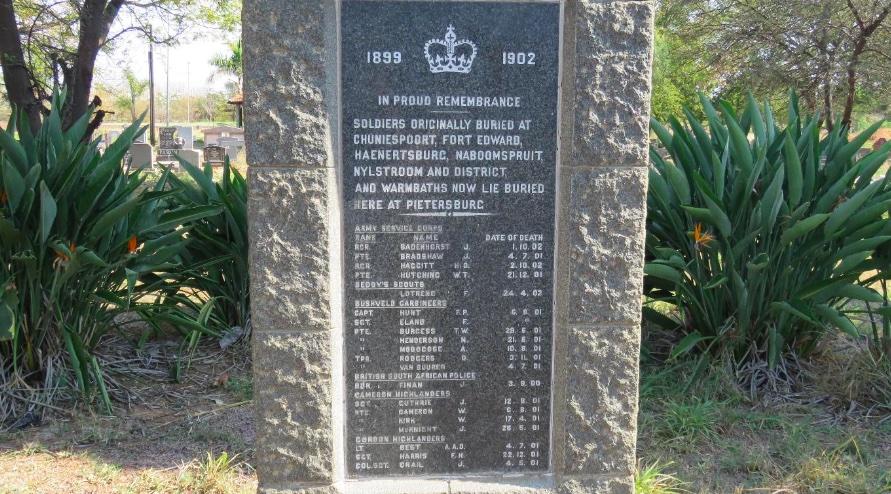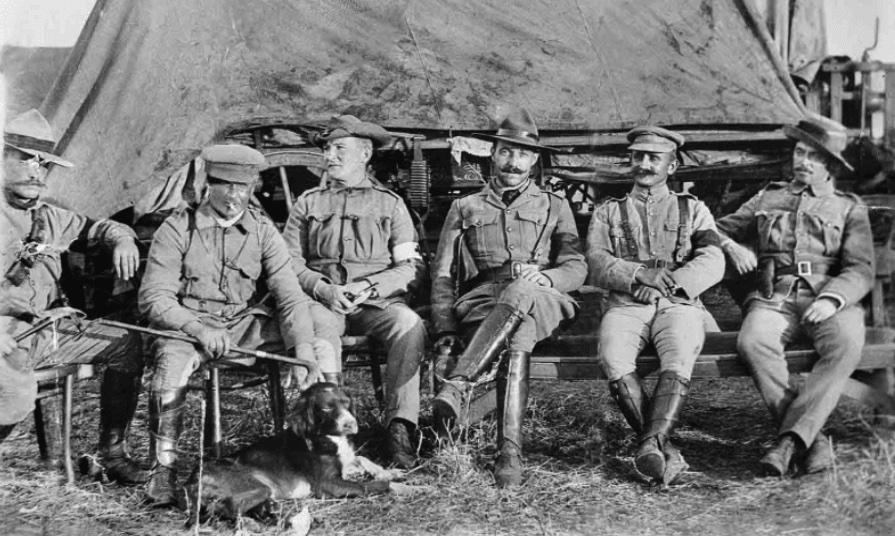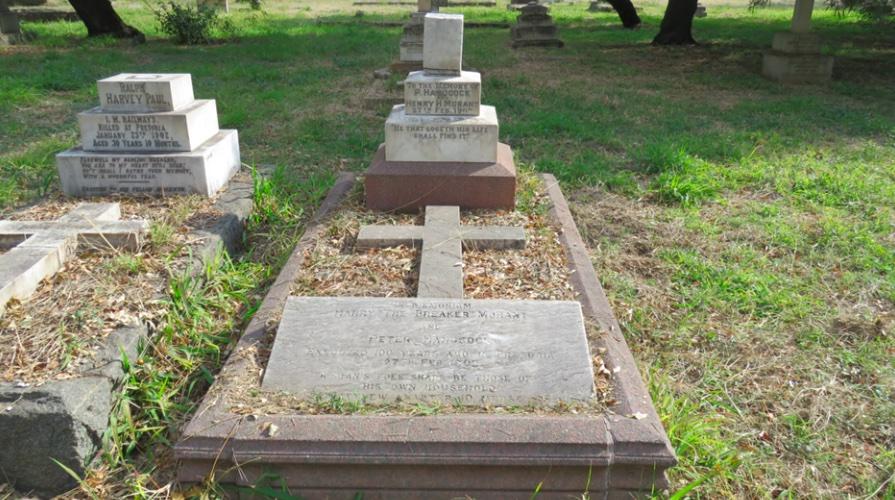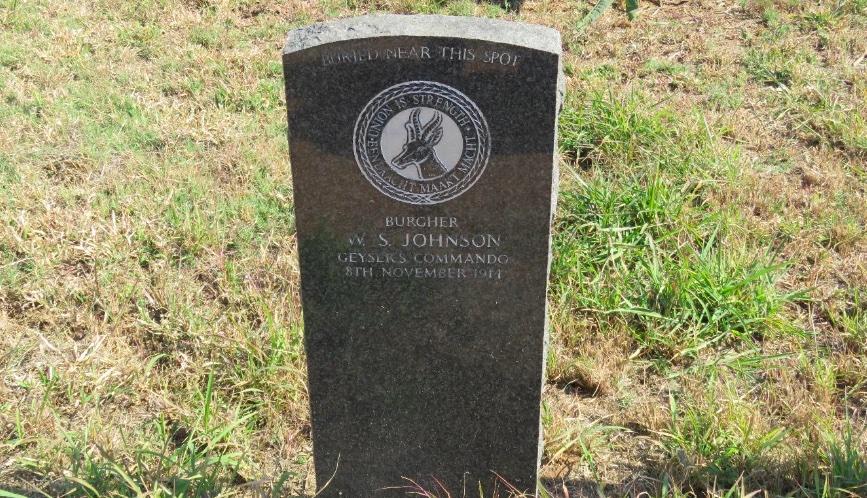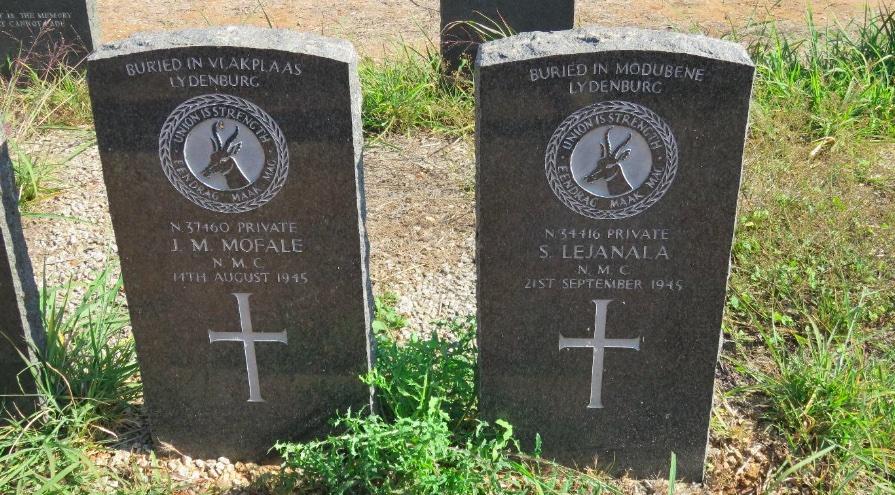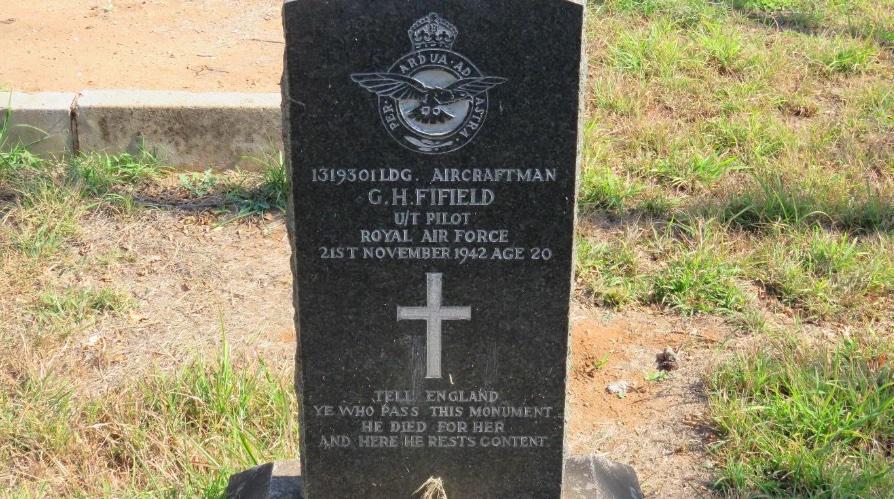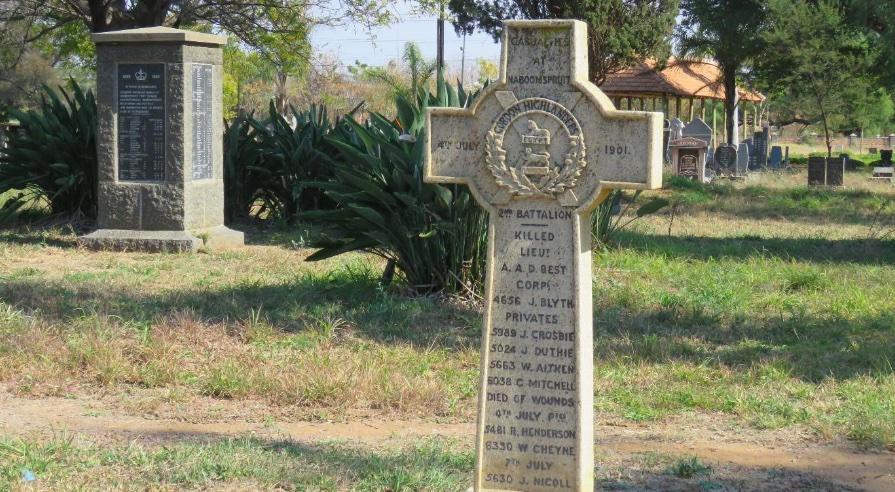
Disclaimer: Any views expressed by individuals and organisations are their own and do not in any way represent the views of The Heritage Portal. If you find any mistakes or historical inaccuracies, please contact the editor.
Recently, returning from a tour to Mapungubwe through the Archaeological Society, one of our travelling companions requested a brief stopover at the Jewish precinct in the old Polokwane Cemetery, to visit the graves of his late maternal grandparents.
This suited me, as I wished to photograph the memorials to the casualties of the British Empire, who had died in the Northern Transvaal during the South African War 1899 - 1902.
The cemetery in Dahl Street was surprisingly well maintained and it was comforting to note the presence of a nearby security guard.
The Jewish precinct and Military Garden of Remembrance are near one another and while my friend visited his grandparents’ graves, I browsed around the war graves.
The main South African War Memorial, to the left in the above photograph, appears to have been erected by the SA War Graves Board and contains the legend, ‘In Proud Remembrance. Soldiers originally buried at Chuniespoort, Fort Edward, Haenertsburg, Naboomspruit, Nylstroom and district, and Warmbaths now lie buried here at Pietersburg.’
The names of 133 Imperial soldiers from 32 military units are engraved on this memorial. Unusual for memorials to the South African War, it also refers to three unknown soldiers from the First World War and names three members of Geyser’s Commando killed during the 1914 Afrikaner Rebellion.
During the 1950’s and 1960’s, the War Graves Board relocated the remains of numerous Imperial soldiers from some of the more outlying and isolated battlefields and cemeteries to the nearest towns to ensure better maintenance of their graves.
This Military Garden of Remembrance contains two other attractive memorials, both in the shape of a Celtic Cross and adorned with engravings of the sphinx and a tiger with an upturned paw, symbolizing the campaigns of the Gordon Highlanders in Egypt and India, respectively. They commemorate the fatalities the 2nd battalion of this regiment suffered from disease and during the Boer derailment and attack on a train some 6 kilometres north of Naboomspruit station, on 4 July 1901.
Lieutenant Alexander Archie Dunlop Best (1879 – 1901) heads the list of names of the nine men of the Gordon Highlanders killed in this skirmish. He commanded the train’s escort of 22 men and reputedly acted with the utmost gallantry while defending the train under attack by more than a hundred Boers.
I was particularly keen to photograph the main memorial displaying the name of Captain Frederick Percy Hunt (1873 - 1901) of the Bushveld Carbineers (BVC). The BVC was essentially a counter insurgency unit, active in the rugged area north-east of Pietersburg. Captain Hunt commanded B Squadron of the BVC, stationed at Fort Edward in the Spelonken area, near the Elim Missionary Hospital, some 22 kilometres south-east of Louis Trichardt (Makhado).
In the minds of most White South Africans, the Bushveld Carbineers will probably always be associated with the deliberate murder of several Boers in this area.
The front side of the SA War Memorial. Captain Hunt is at the head of the 3rd military unit, the Bushveld Carbineers. (SJ de Klerk)
The reign of terror, instigated by Lieutenant Harry ‘The Breaker’ Morant, commenced after his commanding officer, Captain Hunt was killed, while leading 18 of his men on an early morning attack on a group of Boers at Viljoen’s farm in the vicinity of present-day Duiwelskloof (Modjadjiskloof) on 6 August 1901. The Boers having been forewarned, repulsed the attack, killing Captain Hunt and Sergeant Frank Eland in the process. When the BVC returned to the farm the following day, they discovered Hunt’s body had not only been stripped of his clothing but also mutilated. Breaker Morant (1864 – 1902), so named for his skill in breaking in horses, was a close friend of Hunt. Morant was incensed by the killing of Hunt and the mutilation of his body and ordered the immediate execution of several Boer prisoners. He also instructed his subordinates to henceforth take no Boer prisoners. Allegedly, he also conspired with Lieutenant Peter Joseph Handcock (1868 – 1902) to shoot the Berlin Missionary Society’s Daniel Heese, who witnessed the bodies of some of the Boer prisoners who had been shot and was hastening to Pietersburg to report this to the relevant military authorities.
Photo of Officers of the Bushveld Carbineers. Lieutenant Handcock on the extreme left and Morant with dog, with Captain Hunt, 3rd from the right. (National Museum Australia)
In October 1901, Lieutenants Morant, English by birth but Australian by association, Handcock and Witton both Australian, were arrested and charged with the murder of several Boers and Daniel Heese, the German missionary. Although found not guilty of the killing of Heese, Witton later confirmed that Handcock had admitted to him of shooting and killing Heese.
Although there must have been other outrages in the Boer Republics where the offenders in the British army were not charged, the shootings in the Spelonken were on such a scale and involved so many witnesses, British, Boer, and African, military and civilian, that capital punishment for the offenders was probably inevitable. Nevertheless, there appears to be a strong perception in Australia that Morant and Handcock were mere scapegoats of the Empire.
Morant and Handcock’s death sentences were promulgated on 26 February 1902, and both executed the following day in Pretoria. They were both interred in a communal grave in the Military precinct of the old Church Street Cemetery, (now WF Nkomo Street), Pretoria. Witton was sentenced to lifelong imprisonment but released in 1904.
Communal grave of Breaker Morant and Peter Handcock in the Military precinct of the old Church Street Cemetery, Pretoria. (SJ de Klerk)
In 2002, a plaque was placed at the bottom end of their communal grave in Pretoria, that reads: “In Memoriam. Harry ‘The Breaker’ Morant and Peter Handcock executed 100 years ago in Pretoria 27th February 1902. A man’s foes shall be those of his own household. Matthew, Chapter 10, Verse 36”.
Because of the disgrace associated with the Bushveld Carbineers, the unit was disbanded and replaced by the Pietersburg Light Horse. The names of Morant and Handcock were also omitted from the South African War Memorial in the Military Garden of Remembrance in Polokwane.
Although there are no individual tombstones from the South African War in the Military Garden of Remembrance at Polokwane, there are other interesting ones dating from the 1914 Afrikaner Rebellion, the Native Military Corps and of a few trainee pilots from the RAF, who had died in flight accidents at the 26th Air School in Pietersburg during World War II.
The three tombstones from the 1914 Afrikaner Rebellion commemorate little-known clashes between government forces and rebels in the Waterberg.
On Sunday 8 November 1914, Lieutenant Colonel Dirk Van Deventer of the UDF, attacked the laager of the rebels at Zandfontein. In the subsequent clash the UDF suffered twelve casualties, mainly from Geyser’s Commando of the Waterberg.
Tombstone of WS Johnson of Geyser’s Commando. (SJ de Klerk)
Ten of the UDF’s casualties were interred at Zandfontein, now located within a large private game reserve (the Meletse Game Reserve). Three other fatalities on that day, including William Stonewall Johnson, were buried elsewhere. Two other fatalities in the Warmbaths area, killed in other clashes a few days prior (George William Mapham and Herbert John Dewrance), were originally buried at Warmbaths, but Richard Wadley who wrote the definite history of the Waterberg, claims they were subsequently by mistake re-interred together with Johnson in this Military Garden of Remembrance.
Having recently visited and written about the Palmietkuil South War Cemetery at Springs (click here to read), where members of the Native Military Corps (NMC) were buried, I was pleased to discover that the tombstones of nine members of the NMC whose graves I had presumed to be lost, have also been re-erected here.
Tombstones of Privates Mofale and Lejanala, late of the NMC, both previously interred at Lydenburg. (SJ de Klerk)
The tombstones of the young Trainee Pilots from the UK, killed in flight accidents at 26th Air School in Pietersburg, moved me the most. Most likely, because every parent dreads losing a soldier-son in some distant country, with little chance of ever visiting his grave.
Tombstone of Leading Aircraftman GH Fifield aged 20 years, with the modified epitaph of the one by Simonides of Ceos: ‘Go tell the Spartans, stranger passing by, that here obedient to their laws we lie’. (SJ de Klerk)
Translated, the RAF motto on the tombstone, ‘Per Ardua Ad Astra’ means, ‘Through Adversity to the Stars’.
For those interested in South Africa’s rich military history, the Military Garden of Remembrance in Polokwane warrants visiting, but, as in all such visits to isolated cemeteries, remain alert.
Main image: Memorials at the Military Garden of Remembrance in the old Polokwane Cemetery. (SJ de Klerk)
About the author: SJ De Klerk held many senior positions in HR during a distinguished career in the private sector. Since retiring he has dedicated time and resources to researching, exploring and writing about South African history.
Sources:
- Bothma LJ. Rebelspoor. Die aanloop,verloop en afloop van die Boereopstand van 1914 – 15. ABC Press, Epping. 2017.
- Davie A. Breaker Morant and the Bushveld Carbineers. Second Series No. 18 Van Riebeeck Society, Cape Town. 1987.
- Dooner Mildred G. The Last Post being a roll of all Officers who gave their lives for their Queen, King and Country in the South African War, 1899 – 1902. J. B. Hayward & Son. Suffolk. 1980.
- Grobler J. Anglo-Boer War 1899 – 1902. Historical Guide to Memorials and Sites in South Africa. 30° South Publishers, Pinetown. 2018.
- Wadley R. Waterberg Echoes. Protea Book House, Pretoria. 2019.
Comments will load below. If for any reason none appear click here for some troubleshooting tips. If you would like to post a comment and need instructions click here.

